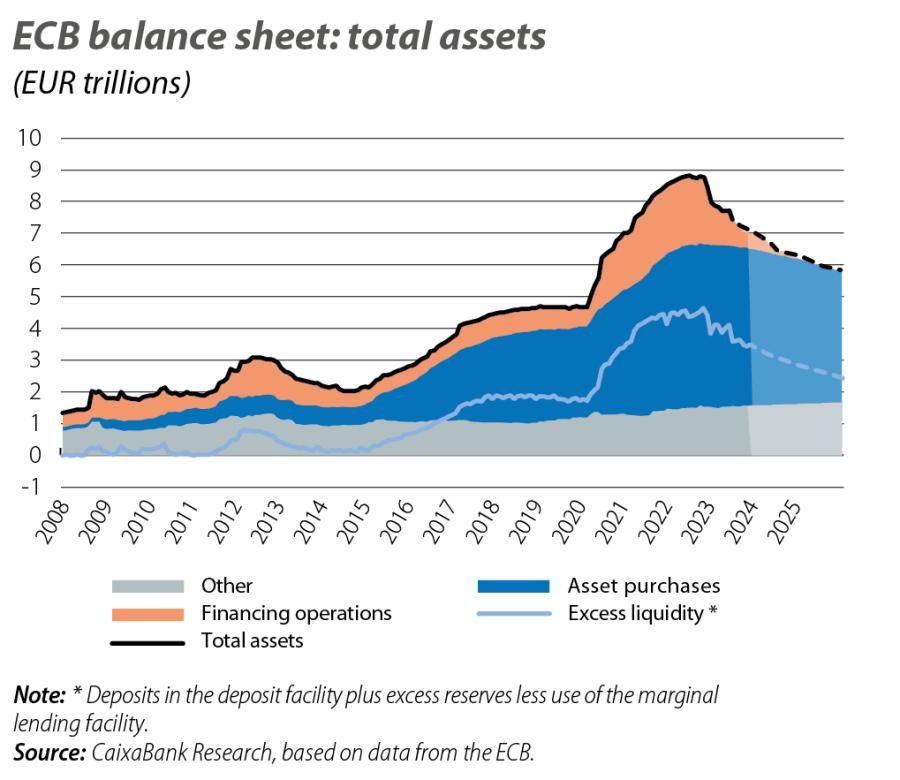The ECB, in the midst of a review
The European Central Bank is reviewing the operating framework with which it implements interest rates. In this article we examine the main question marks in the process.

The ECB directly controls three interest rates, the depo, refi and MLF. The depo rate – or deposit facility rate – is that at which banks can deposit their excess liquidity in the ECB, and it sets a floor for market interest rates (no institution with access to the depo rate would want to lend at lower rates.) At the other end of the scale, the MLF rate is the cost of borrowing ECB liquidity overnight through the marginal lending facility (MLF), and it sets a ceiling on market rates (no one with access to the MLF would want to borrow at higher rates).
In the middle is the refi rate – or main refinancing operations rate – which was the reference rate before the global financial crisis (GFC): given a particular refi rate, the ECB estimated the demand for liquidity in the banking system as a whole and supplied it with loans (with a one-week term) granted at the refi rate (through so-called refinancing operations, which were conducted via auction). After the ECB provided a total supply of liquidity, the interbank market was then responsible for redistributing it among the various institutions. As can be seen in the first chart, the floor and ceiling set by the depo and MLF rates ensured that market rates always remained within that corridor, and pre-GFC the ECB managed to anchor them in the middle (at the refi rate) by injecting a total supply that was very close to the demand.

However, with the GFC and the freezing of the interbank market, the ECB had to assume a more direct role. In 2008, refi-rate loans switched to being granted on a fixed-rate full allotment (FRFA) basis: instead of offering fixed amounts at auction, each institution could obtain as much liquidity as it wished from the ECB. This, and the significant growth in the liquidity of the system, ended up anchoring market rates to the depo rate: the option of depositing liquidity with the ECB became the anchor for the price of all other alternative uses of that abundant liquidity.
The door was opened by the FRFA system in 2008, but liquidity began to accumulate more notably in 2010-2012, following the launch of financial stabilisation tools (with the purchases under the Securities Markets Programme and the VLTRO injections, among others), and it was greatly intensified with the asset purchase programmes initiated in 2015 (APP) and 2020 (PEPP) and with the various rounds of TLTROs (targeted longer-term refinancing operations, granted by the ECB between 2014 and 2021).
With the repayments of the TLTROs that began in 2022 and the reduction of the APP initiated in 2023, there has recently been a steady decline in the size of the central bank’s balance sheet and in the liquidity in the system. It is for precisely this reason that the ECB is now reviewing an operational framework based on excess liquidity.
Excess liquidity and the anchoring role of the depo rate have reduced the volatility of market interest rates. Moreover, compared to the pre-GFC system, the ECB no longer has to accurately estimate the system’s minimum liquidity needs,1 although that does not mean it can relax either: even if liquidity is abundant across the system as a whole, there can be turbulence if it is unevenly distributed, as exemplified by the flash crash of the US federal funds market in September 2019. Finally, an abundance of liquidity has the advantage of maintaining a high volume of safe assets in the system and ensuring protective buffers as a preventative measure in the event of episodes of stress.
- 1. This is no mean feat, given that liquidity needs are now not only higher (both for regulatory reasons and due to an increased perception of risk) but also more uncertain.
The most direct disadvantage is the larger balance sheet size that the central bank must sustain, with the consequent larger footprint in the financial markets (influencing a wide range of interest rates and with collateral effects such as a shortage of bonds in secondary markets). In addition, it entails financial risks for the central bank’s own profit and loss account. Furthermore, the excess liquidity injected by the central bank can discourage the interbank market and distort information on benchmark interest rates such as the €STR.2
- 2. The euro short-term rate (€STR), which reflects the interest rate on overnight loans between financial institutions, trades below the depo rate (its theoretical lower limit). The €STR «leaks» below the depo rate because it includes transactions between entities with access to the deposit facility and institutions without access: these latter transactions would gain relative weight in a less dynamic interbank market, accentuating the «leaks».
The statements seem to favour a system with abundant liquidity and giving continuity to the current framework,3 but with a slightly different implementation.4 Whereas to date the excess liquidity has been proactively injected by the ECB, an alternative approach would be to offer abundant and regular refinancing operations such that it would be demand itself that would determine its liquidity needs. The Bank of England, which has adopted such a system, offers these operations at the same interest rate at which it remunerates the reserves. On the other hand, if the ECB were to follow the example set by the Riksbank, which uses a similar system, it could establish a narrow corridor: for example, with refinancing operations at the refi rate, with this rate falling within a narrow corridor between the depo and the MLF rates (the Riksbank’s corridor is ±10 bps).
In addition to being more self-regulated (demand is self-satisfied and an adequate distribution of liquidity is more easily ensured),5 this system has the advantages of being robust against fluctuations in reserves and allowing the central bank to have a smaller bond portfolio, with a smaller footprint in the markets.
The ECB’s operational review will determine the size and composition of its balance sheet in the long term. In 2024 and 2025, we estimate that it will still maintain a relatively large balance sheet and will continue to operate with abundant liquidity. In particular, during 2023 the size of the ECB’s balance sheet will have dropped by 1 trillion euros due to the repayments of the TLTROs (–0.85 trillion) and the end of reinvestments under the APP (–0.2 trillion). These dynamics will continue in 2024 and 2025, intensified by the end of reinvestments under the PEPP. However, even if they were to affect excess liquidity on a 1-to-1 basis, by the end of 2025 the central bank’s excess liquidity would still exceed 2 trillion euros (see second chart).6 With such ample liquidity, the depo rate would remain the benchmark anchor for market rates (see third chart).7
- 6. This projection assumes the repayment of all the remaining TLTROs (some 500 billion euros by December 2024), the passive reduction of the APP (zero reinvestments) and the passive reduction of the PEPP beginning in the summer of 2024 (three months with reinvestments at 50%, three months more at 30% and then 0%).
- 7. The historical relationship is subject to the usual caveats: structural changes in the demand for reserves could cause the market rate to slide with higher levels of excess liquidity than in the past.

